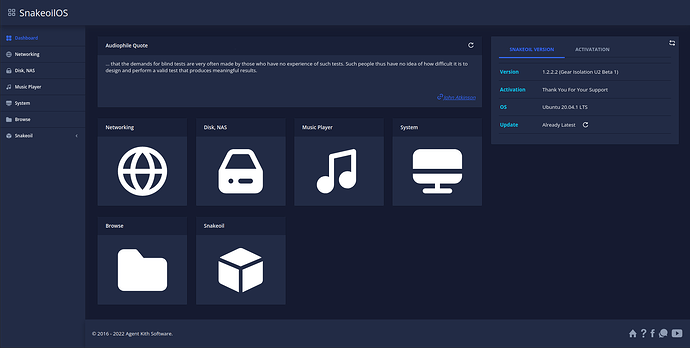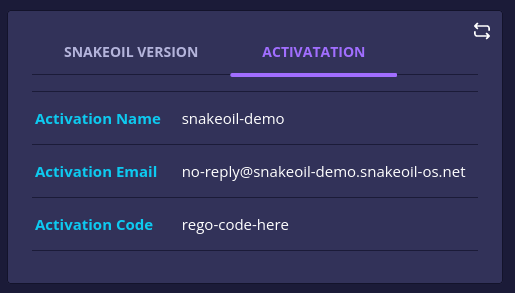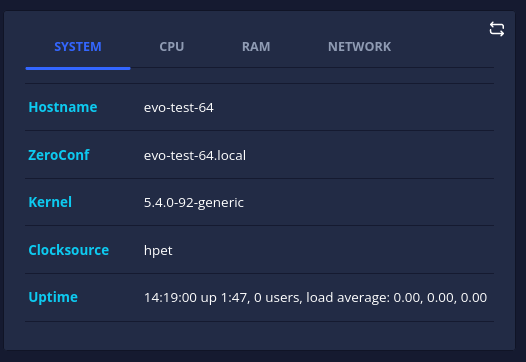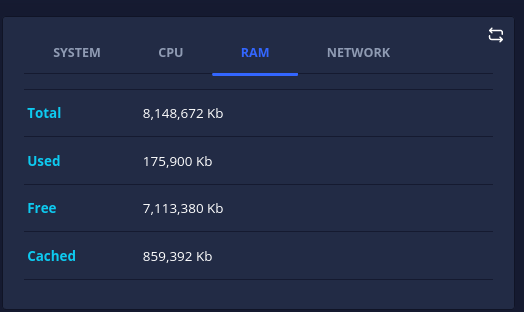The Dashboard is the first content you’d see when you load up the Snakeoil OS WebApp. This page contains general system information, giving you the overall “health” of your Snakeoil OS. This is the place to get a “bird eye’s view” of the state of your Snakeoil OS computer.
Audiophile Quote
People say the darnedest things. In here you’d see some of the more amusing and interesting audiophile related quotes. A new quote is shown every 30 seconds, if you are impatient hit the reload button in the top right to load a new quote immediately.
Snakeoil Information
By default the Snakeoil information is displayed. You can click the flip button (![]() )on the top right to switch between Snakeoil and computer information.
)on the top right to switch between Snakeoil and computer information.
Snakeoil OS Version
Here you’d find the version of Snakeoil OS that’s running on your computer (1.0.0 in the example), plus the underlying version of Ubuntu (16.04.02 LTS). You can click the “Check” button any time to connect to the Snakeoil OS server to find if there is a newer version of Snakeoil OS you can upgrade to. Refer to the “System” section of this manual to find out how to upgrade your Snakeoil OS computer.
Snakeoil Activation
Click on the Activation tab to display
Computer Information
Click on the ‘flip’ button (![]() ) on the top right to switch to computer information.
) on the top right to switch to computer information.
System Information
The final panel gives you some information that you may find interesting - e.g. the load average of your computer system.
RAM
Random-access memory (RAM /ræm/) is a form of computer data storage which stores frequently used program instructions to increase the general speed of a system. A random-access memory device allows data items to be read or written in almost the same amount of time irrespective of the physical location of data inside the memory. In contrast, with other direct-access data storage media such as hard disks, CD-RWs, DVD-RWs and the older drum memory, the time required to read and write data items varies significantly depending on their physical locations on the recording medium, due to mechanical limitations such as media rotation speeds and arm movement.
This panel gives you a quick overview of the general state and health of your memory subsystem. In most cases all your available RAM will be used as “cache”. You’d need to add more RAM if you find more a very high number in the “used” row and very low values for both “free” and “cached”. A good rule of thumb is to have around 50% of your memory in the cache field, but this is just a general guide as it’s pretty much system dependent.
CPU
A central processing unit (CPU) is the electronic circuitry within a computer that carries out the instructions of a computer program by performing the basic arithmetic, logical, control and input/output (I/O) operations specified by the instructions. The computer industry has used the term “central processing unit” at least since the early 1960s. Traditionally, the term “CPU” refers to a processor, more specifically to its processing unit and control unit (CU), distinguishing these core elements of a computer from external components such as main memory and I/O circuitry.
This panel tells you the type of CPU you have, showing important information like:
-
cpu brand (e.g. Intel, AMD, etc)
-
number of cores and threads
-
architecture (32 bit or 64 bit)
-
Cache (L1, L2 and L3)
Networking
This tab will come soon in a future Snakeoil release.






